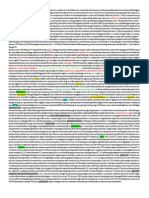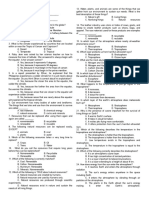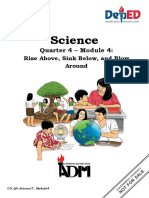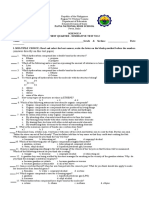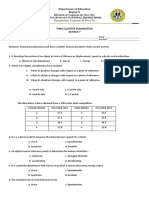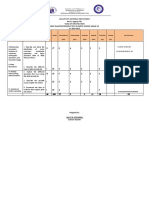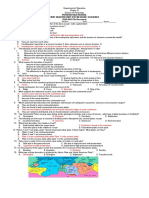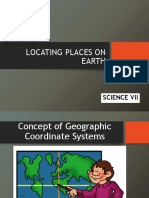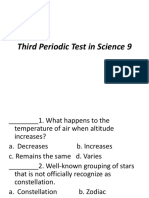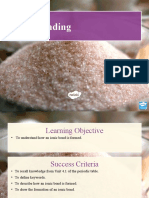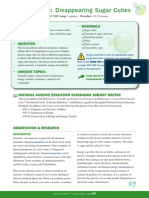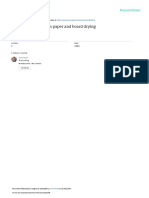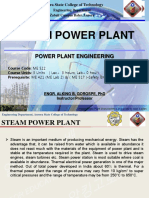Science 7 Assessment 4.3 Multiple Choice
Science 7 Assessment 4.3 Multiple Choice
Uploaded by
Mjnicole MartejaCopyright:
Available Formats
Science 7 Assessment 4.3 Multiple Choice
Science 7 Assessment 4.3 Multiple Choice
Uploaded by
Mjnicole MartejaOriginal Title
Copyright
Available Formats
Share this document
Did you find this document useful?
Is this content inappropriate?
Copyright:
Available Formats
Science 7 Assessment 4.3 Multiple Choice
Science 7 Assessment 4.3 Multiple Choice
Uploaded by
Mjnicole MartejaCopyright:
Available Formats
SCIENCE 7 ASSESSMENT 4.
Multiple Choice
Directions: Read each item carefully then SHADE/BLACKEN THE CIRCLE OF THE LETTER of the correct
answer in the answer sheet provided BELOW.
1. What is the most abundant gas in the atmosphere?
A. oxygen B. carbon dioxide C. nitrogen D. water vapor
2. Satellite communication is an important aspect of daily life that allows us to receive
radio signals that transmit to our phones, computers, and TVs. Where is the
satellite communication taking place in our atmosphere?
A. Mesosphere B. Stratosphere C. Thermosphere D. Troposphere
3. The stratosphere contains the Earth’s ozone layer. The ozone blocks some solar
radiation. What will happen if ozone layer were removed from the atmosphere?
A. The removal of the ozone layer would cause higher temperatures.
B. The removal of the ozone layer would cause an extinction of all life.
C. The removal of the ozone layer would cause a higher rate of skin cancer.
D. The removal of the ozone layer would cause the depletion of natural resources.
4. Which of the following greenhouse gas being produced by humans?
A. Water vapor B. Carbon dioxide C. Methane D. Nitrous oxide
5. What should you do to prevent the occurrence of reduce global warming?
A. Join car pools B. Avoid using disposable items
C. Turn off all appliances when not in use D. All of the above
6. In what way does the atmosphere protects life on earth?
A. by absorbing ultraviolet radiations
B. by warming the surface through greenhouse effect
C. by creating pressure allowing for liquid water to exist on the earth’s surface
D. all of the above
7. What is the correct order of earth's atmospheric layers from bottom to top?
A. Stratosphere, Mesosphere, Troposphere, Thermosphere, Exosphere.
B. Stratosphere, Troposphere, Mesosphere, Thermosphere, Exosphere.
C. Stratosphere, Troposphere, Thermosphere, Mesosphere, Exosphere.
D. Troposphere, Stratosphere, Mesosphere, Thermosphere, Exosphere
8. The gradual increase in the temperature of the atmosphere is known as________________.
A. Methane B. Global Warming C. Greenhouse Effect D. Carbon Dioxide Gases
9. Which will likely to result from excessive cutting down of trees?
A. Providing more fresh oxygen B. Providing more pure water
C. Cause greenhouse effect D. Cause increase in the rain
10. What happens when air is heated?
A. It expands, then rises B. It moves toward a lower elevation.
C. It spreads in all directions. D. It stays in place.
11. Which warms up faster, land or water?
A. Land B. Water
C. Both warm up at the same rate D. Rate of warming varies; depends on weather conditions
12. Which of the statements account for the occurrence of land breeze, sea breeze and monsoons?
I. Warm air goes up.
II. Different locations warm up or cool down differently.
III. Cold air moves “toward” the direction where warm air is rising.
A. I and II B. I and III C. I, II and III D. II and III
13. In what direction do winds blow?
A. From high pressure areas to low pressure areas
B. From low pressure areas to high pressure areas
C. From the northeast to the southwest
D. From the southwest to the northeast
14. How would you explain the occurrence of ITCZ?
I. It is the reason why we have thunderstorms during certain months.
II. It occurs during the warm months when these places is much warmer than
other places on Earth.
III. It happens only in countries near the equator because these places receive
direct rays from the sun.
A. I and II B. I and III C. I, II and III D. II and III
15. Which of the following does NOT describe the amihan?
A. Brings cold weather
B. Brings lots of rain
C. Comes around July to September
D. Comes from the northeast and moves southward
SCIENCE 7 ASSESSMENT 4.4
Multiple Choice
Directions: Read each item carefully then SHADE/BLACKEN THE CIRCLE OF THE LETTER of the correct
answer in the answer sheet provided BELOW.
1. What effect does the tilting of the Earth have?
A. When the Earth is tilted away from the sun, we have day.
B. When the Earth is tilted away from the sun, we have a night.
C. It changes the angle that the Sun strikes the Earth in different land areas.
D. It causes the Earth to be farther away from the Sun at different times of the year.
2. In what angle do the sun rays hit the ground on direct rays?
A. 30 ̊ B. 60 ̊ C. 90 ̊ D. 120 ̊
3. Based from the picture, in which month is the
North pole tilted toward the sun?
A. December B. June
C. March D. September
4. Which of the following is an effect of earth’s tilt on its axis?
A. Eclipse B. El Niño C. La Niña D. Seasons
5. The shortest day of the year which marks the start of the winter.
A. autumnal equinox B. summer solstice C. vernal equinox D. winter solstice
6. How does a solar eclipse happen?
A. When the moon comes directly between the Sun and Earth.
B. When the shadows of Earth and moon are cast in space.
C. When the shadows of moon and Earth is neither too high nor too low.
D. When the Sun is on the opposite side of the Earth and the moon.
7. A total lunar eclipse will occur when the moon moves into the
A. penumbra of the earth B. penumbra of the moon
C. umbra of the earth D. umbra of the moon
8. Which of the following pictures shows the phase of the Moon when a solar eclipse occurs?
A. Full Moon B. New Moon C. Quarter Moon D. Waning Moon
9. Which of the following beliefs and practices have no scientific bases?
I. During eclipse, we are advised to watch in a basin with water.
II. During eclipse, there is an increase in harmful microorganism.
III. During eclipse, alternating light and dark wavy lines can be seen called
shadow bands.
A. I only B. I, II and III C. II only D. III only
10. Which of the following statement is true about umbra and penumbra?
I. Umbra and penumbra are the two types of shadows.
II. Umbra and penumbra are the two types of eclipse.
III. Umbra is the darker inner area, while penumbra is the lighter outer area.
IV. Umbra is the lighter inner area, while penumbra is the darker outer area.
A. I and II only B. I and III only C. I and IV only D. III and IV only
You might also like
- Grade 7 4th Quarter ExamDocument6 pagesGrade 7 4th Quarter ExamSher Sherwin93% (15)
- Green Generation Cheat SheetDocument1 pageGreen Generation Cheat SheetVeraNo ratings yet
- Water Pollution in KosovoDocument42 pagesWater Pollution in KosovoAstrit E. SalihuNo ratings yet
- Science 7 3rd Summative m5-m6Document3 pagesScience 7 3rd Summative m5-m6Melannie MagalongNo ratings yet
- Summative Test 4th 4Document3 pagesSummative Test 4th 4Jerome CasillaNo ratings yet
- Science 7 2nd Summative m3-m4Document2 pagesScience 7 2nd Summative m3-m4Melannie MagalongNo ratings yet
- DLP Sci 7 4QTR W1 D1Document9 pagesDLP Sci 7 4QTR W1 D1Richelle Jane L. ReyesNo ratings yet
- Summative Test Q3 M 3-4Document6 pagesSummative Test Q3 M 3-4Virgen delas flores High SchoolNo ratings yet
- SST Class-V Ch.-4 Weather and Climate Q-ADocument4 pagesSST Class-V Ch.-4 Weather and Climate Q-AAnwar Hussain RaymaNo ratings yet
- SLK - Sci7 - Q4 - Week 4Document13 pagesSLK - Sci7 - Q4 - Week 4malouNo ratings yet
- Grade 7 Science Exam SetsDocument38 pagesGrade 7 Science Exam SetsJennie Ann Galang100% (1)
- 4th Quarter Sci 7Document2 pages4th Quarter Sci 7Zir AdaNo ratings yet
- Evelyn Canonce LAS WK 3Document8 pagesEvelyn Canonce LAS WK 3malouNo ratings yet
- QUARTER 3 Summative Test G9Document6 pagesQUARTER 3 Summative Test G9Angelita MenesesNo ratings yet
- Science 9 3rd Periodical TestDocument6 pagesScience 9 3rd Periodical TestJoan QuitaligNo ratings yet
- Inawayan National High School - Darong Extension Science 7 Semi - Finals I. DIRECTIONS: Choose The Letter of The Best Answer. Write Your Answers inDocument3 pagesInawayan National High School - Darong Extension Science 7 Semi - Finals I. DIRECTIONS: Choose The Letter of The Best Answer. Write Your Answers inRodel Camposo100% (1)
- Processes and Landforms Along Plate BoundariesDocument27 pagesProcesses and Landforms Along Plate Boundariessheila mae obinguarNo ratings yet
- Lesson Exemplar ClimateDocument2 pagesLesson Exemplar ClimateBrianSantillan100% (1)
- Science: Quarter 4 - Module 4Document34 pagesScience: Quarter 4 - Module 4LaviNo ratings yet
- Climates and ConstellationsDocument2 pagesClimates and Constellationsjoan marie PeliasNo ratings yet
- Learning Activity Sheet in Science 9 Quarter 3, Week 1-2Document6 pagesLearning Activity Sheet in Science 9 Quarter 3, Week 1-2Rose Ann ChavezNo ratings yet
- Multiple ChoiceDocument4 pagesMultiple ChoiceJustine PamaNo ratings yet
- Summative ClimateDocument5 pagesSummative Climatesanaol pisoprintNo ratings yet
- Science 8 2nd Quarter (Online)Document2 pagesScience 8 2nd Quarter (Online)Qasa GoldNo ratings yet
- Teaching Module ACADEMIC YEAR 2016-17Document6 pagesTeaching Module ACADEMIC YEAR 2016-17Vedant100% (1)
- Final Revised Las in Science 9 q3w1Document5 pagesFinal Revised Las in Science 9 q3w1Ma.Kristine Ibarreta JazulNo ratings yet
- Q4 Summative Test Science 7Document4 pagesQ4 Summative Test Science 7Anna Liza GomezNo ratings yet
- Science 9 Fourth Quarter ExamDocument3 pagesScience 9 Fourth Quarter ExamEncluna Lindon JayNo ratings yet
- The Richness of The Philippines in Terms of Mineral Resources Is Being Attributed To Its Location in The So-CalledDocument3 pagesThe Richness of The Philippines in Terms of Mineral Resources Is Being Attributed To Its Location in The So-CalledNancy AtentarNo ratings yet
- Science 10 Summative Test q1 Module 1Document4 pagesScience 10 Summative Test q1 Module 1Anafemolyn NingascaNo ratings yet
- GRADE 9 Group 4 - Test QuestionsDocument7 pagesGRADE 9 Group 4 - Test QuestionsMary Grace Lemon0% (1)
- Grade 9 Long Test 3rd QuarterDocument3 pagesGrade 9 Long Test 3rd QuarterS2 Princess M. NatividadNo ratings yet
- Las Science 7 Q4 W3Document7 pagesLas Science 7 Q4 W3Juliet GalletesNo ratings yet
- Factors Affecting Climate: 1.latitude 2.altitude 3.distance From The Sea 4.ocean Currents 5.land TopographyDocument54 pagesFactors Affecting Climate: 1.latitude 2.altitude 3.distance From The Sea 4.ocean Currents 5.land TopographyMeljean Kalaw CastilloNo ratings yet
- Science 9 Summative Test 1Document2 pagesScience 9 Summative Test 1Ma. Socorro HilarioNo ratings yet
- Activity 1 - When The Sun Rays StrikeDocument2 pagesActivity 1 - When The Sun Rays StrikeJONJONNo ratings yet
- 4 Long Test Practical Science 9 Grade 9-GenerosityDocument3 pages4 Long Test Practical Science 9 Grade 9-GenerosityCatherine Joy ZamoraNo ratings yet
- Science 7 Exam 3rdDocument8 pagesScience 7 Exam 3rdEJ Atsilab100% (2)
- Third Quarter Examination Grade 9 Science Name: - Date: - Score: - Encircle The Letter of The Correct AnswerDocument2 pagesThird Quarter Examination Grade 9 Science Name: - Date: - Score: - Encircle The Letter of The Correct AnswerSharonNo ratings yet
- TOS (1stPT)Document2 pagesTOS (1stPT)Sally Pocamas100% (1)
- Potrero High School First Quarter Unit Test in Grade 10-Science 2016-2017 File DocumentDocument3 pagesPotrero High School First Quarter Unit Test in Grade 10-Science 2016-2017 File DocumentRenato PelayoNo ratings yet
- Periodic Test in Science 9: Item Placement Easy Average DifficultDocument7 pagesPeriodic Test in Science 9: Item Placement Easy Average DifficultJESSIE BORRESNo ratings yet
- Locating Places On EarthDocument13 pagesLocating Places On EarthJessica Manawes Navor100% (1)
- Third Quarterly Examination For Science 7Document3 pagesThird Quarterly Examination For Science 7Jon Mitchel Galang100% (1)
- Balisi 3RD PERIODICAL-TESTDocument5 pagesBalisi 3RD PERIODICAL-TESTSarah Jane NomoNo ratings yet
- Reading Comprehension - Absolute LocationDocument2 pagesReading Comprehension - Absolute Locationthuyb2608No ratings yet
- SCIENCE 9 Fourth Quarter ExamDocument2 pagesSCIENCE 9 Fourth Quarter ExamBert RoseteNo ratings yet
- Science 7 q4 w2 Natural ResourcesDocument13 pagesScience 7 q4 w2 Natural ResourcesJelyn LMNo ratings yet
- Third Periodic Test in Science 9Document38 pagesThird Periodic Test in Science 9Raymond BugagaoNo ratings yet
- SLK - Sci7 - Q4 - Week 3Document23 pagesSLK - Sci7 - Q4 - Week 3malouNo ratings yet
- Summative Test Earth and Space 10 Name: - Grade/Section: - ScoreDocument4 pagesSummative Test Earth and Space 10 Name: - Grade/Section: - ScoreZy RianNo ratings yet
- 4TH Exam - Sci 7Document4 pages4TH Exam - Sci 7Julius Magaru Raquel100% (1)
- Science 7 3rd QuarterDocument3 pagesScience 7 3rd QuarterMichelle Baltazar Bazar100% (2)
- Science 7 Q4 W3Document9 pagesScience 7 Q4 W3Khryzha Mikalyn GaligaNo ratings yet
- Libertad National High School First Quarter Exam in Grade 10 Science SY 2019-2020Document4 pagesLibertad National High School First Quarter Exam in Grade 10 Science SY 2019-2020Dindo G. PetalloNo ratings yet
- Science Quiz Bee Questions 2015Document3 pagesScience Quiz Bee Questions 2015melba escuetaNo ratings yet
- Science 7 First Quarter ExamDocument4 pagesScience 7 First Quarter Examgleen barrientosNo ratings yet
- Chapter 2-Atomic Structure Worksheet AnswersDocument2 pagesChapter 2-Atomic Structure Worksheet AnswershomamunfatNo ratings yet
- Name: - Grade Level/section: - DateDocument4 pagesName: - Grade Level/section: - DateJunard AsentistaNo ratings yet
- Released ItemsDocument8 pagesReleased Itemsapi-299499242No ratings yet
- Activity Sheet in Science 7 2 Quarter, Week 1 - (Identify Parts of The Microscope and Their Functions)Document17 pagesActivity Sheet in Science 7 2 Quarter, Week 1 - (Identify Parts of The Microscope and Their Functions)John Ryan PiolNo ratings yet
- Science 7 Summative Test 4thmod.2Document3 pagesScience 7 Summative Test 4thmod.2Marian Anion-Gaurano100% (1)
- Hydrocracker Complex Presentation For BPST 23Document50 pagesHydrocracker Complex Presentation For BPST 23fbriandityaNo ratings yet
- Ionic Bonding PresentationDocument21 pagesIonic Bonding PresentationCheezy NachosNo ratings yet
- Test1 MarkingDocument6 pagesTest1 MarkingMarcus PoonNo ratings yet
- Chapter 1 - Water Resources Quality+Document15 pagesChapter 1 - Water Resources Quality+Nazrina RinaNo ratings yet
- Properties of Gaseous FuelsDocument11 pagesProperties of Gaseous FuelsIan Dave OpaoNo ratings yet
- Chapter 16 Green ChemistryDocument32 pagesChapter 16 Green ChemistryMaitha AlhammadiNo ratings yet
- PVU UPDATE 3rd AccountDocument17 pagesPVU UPDATE 3rd AccountmarklawrencesenerezNo ratings yet
- Inner Conversations - Creative Writings About LifeDocument69 pagesInner Conversations - Creative Writings About LifeAzhley09No ratings yet
- Growatt ES5000Document2 pagesGrowatt ES5000Fudin BiliNo ratings yet
- Module On Phy 102 Electricity Aug14Document71 pagesModule On Phy 102 Electricity Aug14Denver C CaloniaNo ratings yet
- Disappearing Sugar Cubes PDFDocument12 pagesDisappearing Sugar Cubes PDFboyboNo ratings yet
- NT Fire 038 Building Materials Combustible Content.Document3 pagesNT Fire 038 Building Materials Combustible Content.ironfaceNo ratings yet
- 10 Amazing and Incredible Space Facts For Smart KidsDocument3 pages10 Amazing and Incredible Space Facts For Smart KidsDaniyal ShaikhNo ratings yet
- Hvac and Refrigiration System: Group 1Document52 pagesHvac and Refrigiration System: Group 1Jessa Mae CatabayNo ratings yet
- Welding MetallurgyDocument6 pagesWelding MetallurgyPriyankaNo ratings yet
- Periodo DevónicoDocument11 pagesPeriodo DevónicoCesarNo ratings yet
- Linnhoff Sahdev - Pinch TechnologyDocument7 pagesLinnhoff Sahdev - Pinch Technologyjotarm931No ratings yet
- Discord 3Document2 pagesDiscord 3Huyền My Nguyễn TrầnNo ratings yet
- Cooling Tower Management System BrochureDocument12 pagesCooling Tower Management System BrochureTiffany CombsNo ratings yet
- New Developments in Paper and Board DryingDocument10 pagesNew Developments in Paper and Board DryingSahil DesaiNo ratings yet
- ME 522 - Power Plant Engineering - Steam Power Plant - Part 1 - LectureDocument56 pagesME 522 - Power Plant Engineering - Steam Power Plant - Part 1 - LectureJom Ancheta BautistaNo ratings yet
- Multiple Choice Questions (Relativity)Document4 pagesMultiple Choice Questions (Relativity)Ghulam Farid100% (3)
- Battery ExamDocument5 pagesBattery ExamLawrence LawrenceNo ratings yet
- Definitions of Ch-7 Weather and ClimateDocument15 pagesDefinitions of Ch-7 Weather and ClimateBhatia ParulNo ratings yet
- Els q1w2 Earths SubsystemDocument28 pagesEls q1w2 Earths Subsystemhabulinngbakla6969No ratings yet
- Webquest Lesson PlanDocument7 pagesWebquest Lesson Planapi-242505437No ratings yet
- Flare Calc Sheet API RP 521Document18 pagesFlare Calc Sheet API RP 521Cesar Ricardo Lopez ValerioNo ratings yet
- CE011 - Week 4Document23 pagesCE011 - Week 4isidro ylananNo ratings yet

